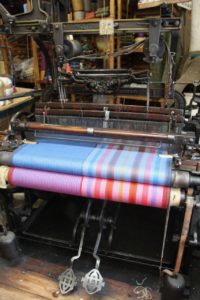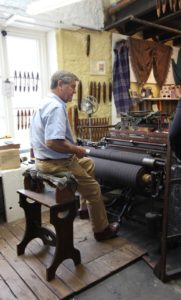Weaving a small Dhurrie in Rajasthan
A mechanism for weaving textile of any weight from the finest silk to the chunkiest carpet. The simplest loom is a wooden frame onto which warp yarns are stretched and fixed on two opposite sides–usually the top and bottom. The weft yarn is then repeatedly passed through–under and over–the warp threads, in effect creating a woven cloth. There are many types of loom: upright looms, backstrap looms, table looms, pit looms, horizontal looms, counterbalance looms, countermarch looms, inkle looms, tapestry looms, handlooms, treadle looms and power looms.
The power loom was invented by Edmund Cartwright in 1790. Handlooms prevail across the world in all developing countries, where the local economy still depends on handcraft.
There are many hand weavers making beautiful work today, in the contemporary field, small business working from home supply craft and design fairs and private clients. And of course the Isle of Harris is lauded across the globe for the small runs of unique design, quality, and colouration of their woven cloth.
In the Uk the weavers dyers and spinner journal is a good resource https://journalwsd.org.uk
I include this because, when I was a teenager, my mother and I bought these handwoven wools from Dartington for our winter coats.
This loom and shop in south west of England is Bovey Weavers. In 1938 a weaver called Angus Litster came to Dartington Hall, founded by Leonard Elmhirst, adding the Scottish weaving to the textile mill. Today their daughter Liz and husband Stuart still use the old wooden handloom to make their beautifully soft scarves and throws, alongside full width tweeds on semi-automatic handlooms.



